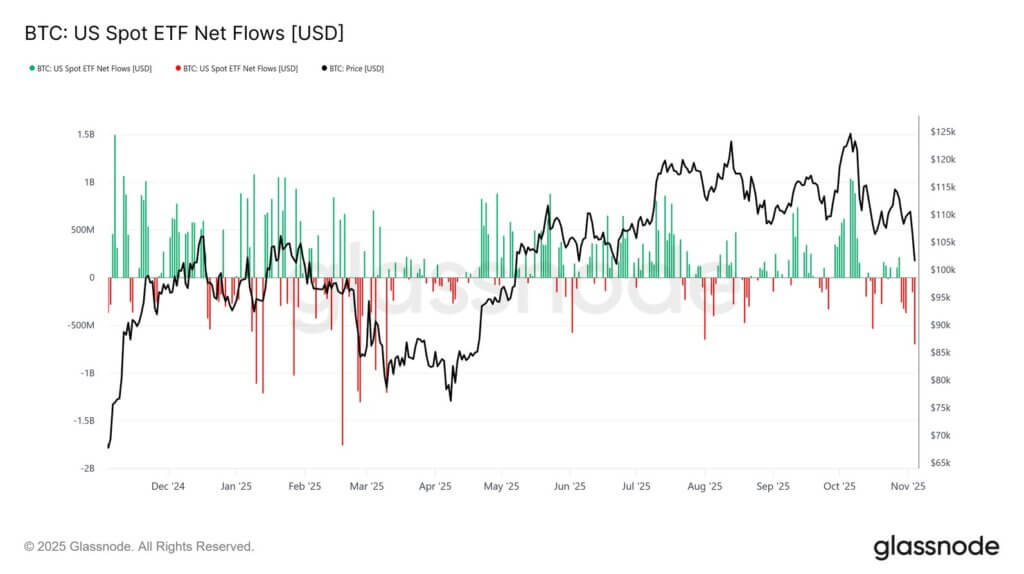US-traded spot Bitcoin (BTC) exchange-traded funds’ (ETFs) flows turned net positive after nearly a week of redemptions.
According to Farside Investors’ data, US spot Bitcoin ETFs recorded $240 million in net inflows on Nov. 6, following six consecutive sessions that drained more than $660 million from the products.
BlackRock’s IBIT led with $112.4 million, followed by Fidelity’s FBTC at $61.6 million and Ark 21Shares’ ARKB at $60.4 million.
The movement means that the largest marginal buyers in the Bitcoin market just stopped selling and started buying again.
Although one green day doesn’t erase a week of red, in a market where liquidity determines price action more than sentiment, the reversal matters because ETF flows are no longer just demand signals. The funds have become a liquidity infrastructure.
Since launch, US spot ETFs have accumulated over $60.5 billion in net inflows and control roughly $135 billion in assets under management. That represents approximately 6.7% of all Bitcoin in existence, held in products that cater to regulated-access demand.
When those products flip from net redemptions to net creations, they don’t just change the headline, but rather the mechanical pressure on order books.
The arithmetic of absorption
Following the halving, miners issue approximately 450 BTC daily. At current prices of nearly $102,555.06, that translates to over $46 million in new supply entering the market every day.
A single $240 million inflow day absorbs more than five days of global issuance through US ETFs alone. This isn’t metaphorical buying pressure, but a programmatic demand executing through authorized participants who must purchase BTC to create new shares.
When ETF flows turn negative, the process reverses. Authorized participants redeem shares and sell Bitcoin back into the market or into their internal inventories, creating constant and predictable sell pressure at the margin.
When flows flip positive, those same participants buy in size to meet demand for creation.

Because ETFs now control a mid-single-digit percentage of total supply and serve as the primary vehicle for institutional allocation, their net flow has become the cleanest measure of large, trackable marginal liquidity in Bitcoin.
The market structure has changed. Liquidity for BTC no longer primarily resides on Binance’s spot and perpetual futures markets, but also lives in what IBIT, FBTC, and their peers are doing with daily creations and redemptions.
Two conditions, one met
Recent analysis from Glassnode identified two requirements for Bitcoin bulls to regain structural control: consistent positive ETF flows and a reclaim of roughly $112,500, the short-term holder cost basis, as support.
The Nov. 6 inflow satisfies the first condition in miniature. It demonstrates that real TradFi demand still exists at current prices, willing to buy the dip via ETFs rather than abandon the product after a $1.9 billion outflow stretch.
One print doesn’t rewrite the structure. Over the past week, ETFs have remained net negative.
However, the moment those daily bars flip from red to green and stay there, the market turns off a major systematic seller and turns back on a buyer capable of outbidding both new issuance and a portion of long-term holder distribution.
That’s when the “ETF flows plus $112,500 reclaim” combination becomes a credible setup rather than wishful thinking.
Four channels to tighter markets
The liquidity impact operates through multiple channels simultaneously.
First, positive ETF flows pull coins from liquid spot venues into ETF custody, where they remain relatively stable, thereby immediately reducing the tradable float. A thinner spot float combined with steady or rising demand creates more sensitive order books.
Once buyers lean in, transactions occur more quickly and with less volume.
Second, when US ETFs enter net-buy mode, authorized participants sweep liquidity across major exchanges to fulfill creation orders. That tightens spreads at the top of the book, but drains resting asks.
In a market already dealing with lower post-halving issuance and heavy HODL concentrations, ETF bid returns are the kind of structural flow that can fuel an upside break, rather than every rally being absorbed by sellers.
Third, the $135 billion ETF complex adds “paper” liquidity in the form of deep, regulated trading in ETF shares themselves. This makes it easier for pension funds, registered investment advisor platforms, and corporations to allocate or rebalance without affecting spot markets.
When those players turn net buyers, Bitcoin’s effective demand base broadens, and volatility from purely crypto-native leverage gets better absorbed by diversified flow.
Fourth, there’s signal value. After a week where outflows tracked broader risk-off positioning and long-term holders quietly distributed into weakness, a decisive inflow day from the most significant brand-name funds represents an important shift in sentiment.
The inflows indicate that large allocators remain comfortable adding Bitcoin exposure via ETFs at near six-figure prices, which supports the thesis that sub-$100,000 wicks are being treated as opportunities rather than regime breaks.
Snapping a six-day, $660 million outflow streak with $240 million of fresh creations doesn’t end Bitcoin’s correction or guarantee the next leg up. But it does something more important for market structure: it removes mechanical sell pressure from the single largest category of marginal buyers.
For now, the pressure flipped. Whether it stays flipped determines whether Bitcoin’s liquidity environment supports consolidation or another test of support.




